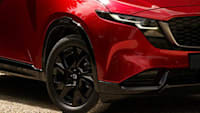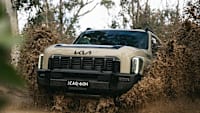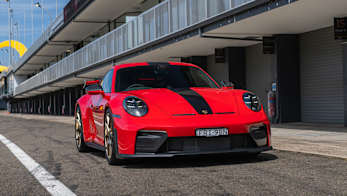Kia is on a roll when it comes to electric vehicles (EVs), due to the spectacular achievements of the EV6.
The strikingly-styled family-sized sister model to the equally stellar Hyundai Ioniq 5 has been a true gamechanger, democratising key EV technologies like 800-volt fast-charging capability, while its almost-universal acclaim has catapulted the brand to the forefront of electrification as well as into premium territory for the first time.
However, with production that cannot keep up with demand, excessive wait times and pricing that breaches $100,000 for the GT high-performance flagship, there are downsides to the EV6’s upward trajectory.
-
You have to be rich to buy an electric car! Here's why EVs like Tesla Model 3, Hyundai Ioniq 5, MG ZS and Kia EV9 cost so much, and when the prices will come down
-
From drab to desirable: Kia's electric car revolution has helped change the way Australians look at the Korean brand
-
Behold the $130K+ Kia! 2024 Kia EV9 GT flagship confirmed as high-performance seven-seater electric rival to Toyota LandCruiser!
Furthermore, its success also means that Australians expecting more-affordable Kia EVs in the near future may have to either look elsewhere such as to MG and BYD, or wait years for the next generation of Kia EVs to come on stream.
Case in point is Kia’s decision not to import the smaller-battery EV6 such as the US-market entry-level Light ‘Standard Range’ (SR) with a 58kWh battery; it would be more affordable than the $72,590 (all prices are before on-road costs) Air featuring the ‘Long Range’ (LR) 77.4kWh battery pack.
In markets like Canada where the EV6 SR models are available, prices are roughly up to $9000 cheaper than their LR equivalents, revealing that – potentially – an EV6 SR could cost as little as $64,000 here. That’s a significant saving.
According to Kia Australia (KAU) Chief Executive Officer, Damien Meredith, there’s no point planning for a cheaper EV6 when the company is struggling to meet orders for the more expensive models.
“When those vehicles become available we can put our hand up for them,” he told the Australian media at a press conference in Sydney earlier this month.
“(But) we are so tight on supply. We have ongoing internal discussions all the time about variants, colours, etcetera, and how many permutations and combinations there are in regards to something you sell 200 a month; do you need three levels and six colours? Complexity is always up for discussion.”
.jpg)
Likewise, the smaller (and less advanced) Niro EV, only comes with an LR battery (at 64.8kWh), so it too is far from affordable, kicking off from $65,300. In contrast, the related Hyundai Kona Electric currently offers a smaller (39.2kWh) SR battery to help keep the price down to a more-accessible $54,500.
Nonetheless, with fresh styling inside and out, the latest Niro range has proven to be another premium-priced hit for Kia around the world.
“It’s the little EV that keeps on giving,” Meredith explains. “Because the EV and hybrid variants go pretty well for us.
“In regards to EV (pricing), there’s still a lot of early adopters still out there, a big pool still buying what they can. We’re pretty fortunate that we’ve worked hard on the brand, and that attracts a certain type of buyer.
“We don’t expect Niro to be taking on MG or the likes of that. Where we’ve positioned it, it’s doing its job for us – and from a fleet point of view, it’s doing exceptional well.
"So, we’re doing alright with its pricing strategy.”
.jpg)
Meredith also points to spiralling battery sourcing and manufacturing costs as the main culprit of high prices across the entire EV industry.
“The costs of putting those things together isn’t getting any cheaper, and nor are the things that are dug out of the ground to power them,” he said.
According to KAU product planning manager, Roland Rivero, continuously high global demand is also a factor, putting the local outfit in a weaker position to negotiate a lower price.
“It’s relative to supply too,” he explained. “Niro does extremely well in Europe, so the lion’s share (of production) goes to Europe. We don’t get as much, and the pricing lines up with that (accordingly).”
Rivero added that models like the EV6 and Niro are there to build on Kia’s popularity and solidify its newfound premiumnness, rather than chase the cheaper Chinese brands, and it’s an opportunity the company has no intention of squandering.
“Right now, our EV products represent the upper end of our range,” he revealed. “They are the brand enhancement and halo (models) of our range.
.jpg)
“It’s having the effect of not only lifting the desirability of the Kia brand, but the desirability of just about every other product in the Kia range. The EV’s roles are – for the moment – to be more aspirational and inspirational.
“Maybe down the track, as that range gets bigger and bigger, and we get better supply, we can look at some more affordable ones. But to say we’ll have an MG (rival won’t happen right now).”
In fact, the opposite is true, with the upcoming all-new EV9 – the full-sized three-row all-electric SUV – further pushing Kia up into luxury territory. It is expected to break through the $130,000 barrier in some versions.
Just three years ago, such lofty ambitions would have been unthinkable for the brand that was once a byword for cheapness.
So, when does Kia predict EVs will eventually become less expensive than their internal combustion engine (ICE) vehicle equivalents, and thus overtake them as the dominant powertrain in pure volume?
According to Meredith, not before the end of this decade at the very least.
.jpg)
“It’s a tipping point, isn’t it,” he believes. “When’s EV going to be selling more than ICE? Is it 2032 or 2033, or as some people think, is it going to be 2030 or even 2028?
“Well, it’s not going to be 2028 in Australia….”
To that end, earlier this week, the Hyundai Motor Group that Kia belongs to released its future roadmap strategy at a CEO Investor Day conference.
Among other big innovations, the plan features a $40 billion investment in electrification that will include the new-generation Integrated Modular Architecture EV-dedicated platform, new EV production facilities that repurposes existing ICE factories, improved battery sourcing security and greater battery development advancements.
These will result in EVs of more shapes and sizes than ever before from Kia (and Hyundai and Genesis), and should include everything from city-sized crossovers to utes (beyond the coming Tasman) and SUVs.
All are designed to slash costs as it strives to sell over two million EVs annually by 2030, with meeting the challenge of China’s emergence in this field singled out as a prime goal.
So, cheap Kia EVs are coming… just not yet.









.jpg)

.jpg)



.jpg)
.jpg)



.jpg)







.jpg)
.jpg)
.jpg)